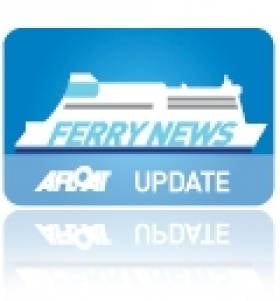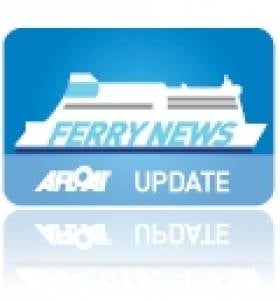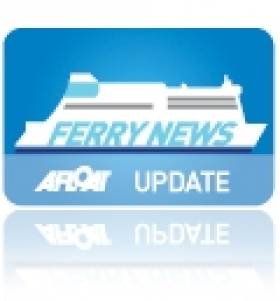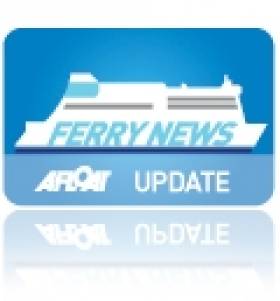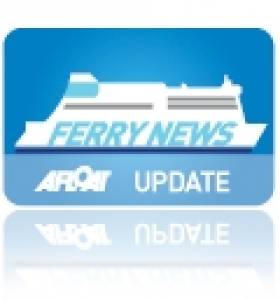Displaying items by tag: InCat
Partnership Sees Brittany Ferries, Wärtsilä and Incat Sign Deal on Zero-Emissions Ferry Project
Ferry operator Brittany Ferries, marine power/technology firm Wärtsilä, and shipbuilder, Incat have signed a partnership deal to explore the design and technical requirements for a 137m zero-emissions craft.
The project comes as Brittany Ferries nears completion of the biggest fleet renewal programme in its history (Afloat highlights the Stena Ro Ro E-Flexer class). The five new E-Flexer vessels will have joined the fleet between 2020 and 2025, including two LNG-powered ships (currently in service) and two shore-power-ready LNG-electric hybrids (Saint Malo and Guillaume de Normandie).
The tripartite deal brings together heavyweight marine partners with complementary strengths. Expertise includes the design and construction of fast craft, all aspects of engineering and technical needs, and experience in operating a large and diverse fleet.
Wärtsilä is a supplier to all five new ships in Brittany Ferries’ on-going fleet renewal project. This includes LNG engines that power Salamanca, which joined the fleet in 2022, and Santoña in 2023. In addition, Wärtsilä is installing LNG-hybrid drivetrains for hybrid vessels, currently under construction and set to sail for Europe by the end of this year.
Brittany Ferries took delivery of an Incat fast-ferry in 2005. Under the name Normandie Express, the high speed craft sped from Tasmania to France and served the company until 2021. The catamaran craft is currently under charter from Brittany Ferries to Condor Ferries operating with the name Condor Voyager, operating St. Malo – Channel Islands routes.
Brittany Ferries is a minority shareholder (of the Guernsey based) Condor Ferries and chief executive Christophe Mathieu is also Condor’s CEO.
“This is an important project as we look at different ways to reach net zero by 2050,” said Christophe Mathieu. “All-electric power is a potential solution, best suited to shorter ferry routes. At this stage we don’t know what is feasible, and upon which route, but what we can say is that trusted partners will help us scope it out. Upon completion of the project we can move quickly. Brittany Ferries has a track record of walking the talk when it comes to leading the industry on sustainable ferry travel, as our investment in LNG and hybrid ships shows.”
“Ferries play a vital role in meeting the growing demand for environmentally sustainable transport options, and the investment Wärtsilä makes in R&D to develop technologies and integrated solutions are key in enabling this development,” added Roger Holm, President of Wärtsilä Marine and Executive Vice President at Wärtsilä Corporation. “This is why we are proud to have been selected to support Brittany Ferries in their goal of bringing cleaner vessels to the regions in which they operate. As a leader in shaping the decarbonisation of the marine industry, we value our long-term relationship with both Brittany Ferries and Incat, sharing a joint commitment to accelerate the industry towards net-zero emissions shipping,”
“Incat has long standing and successful relationships with Brittany Ferries and Wärtsilä, built upon shared values and a vision for innovation and environmental sustainability,” added Stephen Casey, Chief Executive Officer Incat.
“We know that battery electric propulsion coupled with lightweight aluminium vessels is the ideal choice to eliminate emissions, and we are thrilled to be continuing our relationship with both Brittany Ferries and Wärtsilä as we collectively lead the next evolution of sustainable maritime transport throughout Europe.”
Bank Holiday Marks Start of Manx Sailings
#ISLE OF MAN FERRY – This Easter bank holiday weekend marks the start of the Isle of Man Steam Packet Co.'s seasonal-only Dublin-Douglas ferry service, with a sailing scheduled to depart this evening, writes Jehan Ashmore.
The wave-piercing catamaran fastcraft Manannan had departed the Manx capital this afternoon to form the inaugural outbound sailing, which takes nearly three hours to complete. The 96m fastcraft is the largest of her type in the Irish Sea and she was built by InCAT in Hobart, Tasmania. She also maintains sailings on the Douglas to Belfast and Liverpool routes.
For sailing timetables across the network of routes to the Isle of Man click HERE and for a guide about the fastcraft and conventional ferry Ben-My-Chree click this LINK.
Countdown to the Return of the HSS
#FERRY NEWS-A month from today sees the resumption of fast-ferry sailings on the Dun Laoghaire-Holyhead route, operated by Stena Line's HSS Stena Explorer, writes Jehan Ashmore.
The 120 minute central-corridor route closed in mid-September due to consistent high operating costs in recent years. This led to the withdrawal of the fuel-thirsty HSS craft which is powered by four gas-turbine engines.
In addition most of the route's turnover was generated in the high season months, leaving the remaining months unsustainable. As such the company decided to make the service as a seasonal-only operation. To read a previous report of the closure click HERE.
The ending of the year-round-service was the first major break to the route since the introduction of the pioneering HSS Stena Explorer in 1996 which in turn had replaced conventional tonnage. The Finnish built craft was the first of a trio of sisters commissioned for Stena Line and only this vessel remains in service for the operator.
Also operating on the route in recent years was the smaller fast-ferry craft Stena Lynx III which had served several high and low seasons, though she will not be joining her larger fleetmate. The Tasmanian built Incat fastcraft was sold last year to South Korean interests as previously reported on Afloat. ie
Meanwhile the company's Dublin-Holyhead route is maintained by conventional tonnage vessels, Stena Adventurer and Stena Nordica which operate the 3 hour 15 minute service.
Ferry Changes on Dublin-Isle of Man Route
#FERRY NEWS- This weekend's round-trip Douglas-Dublin sailings are to be served by fast-ferry Manannan (1998/5,743grt) instead of conventional ferry, writes Jehan Ashmore.
Usually these winter sailings are operated by Ben-My-Chree (1998/12,504grt), as the Dutch built ro-pax is in dry-dock at Cammell Laird, Birkenhead for repairs to her bow-thruster.
The InCAT built Manannan will cover these sailings with an arrival in Dublin Port this evening at 22.00hrs. She spends a short-around in port lasting only 45 minutes, before returning to the Manx capital.
Farewell as Stena Line’s ‘Lynx’ Fast-Ferry Sets Sail for South Korea
Sunflower 2 is to make bunker calls on the repositioning voyage, firstly in Valletta, Malta before she transits the Suez Canal to the Red Sea port of Jeddah, Saudi Arabia and Columbo, Sri Lanka. From there she transits the Strait of Malacca then through the South China Sea followed by the East China Sea before finally entering the Strait of Korea to her homeport of Busan.
Since 1999 she has served Stena Line's fast-ferry high-season Rosslare-Fishguard route sailings taking 1 hour 50 minutes in tandem with conventional ferry Stena Europe (1981/24,828grt) which currently maintains the year-round 3 hours 30 minutes route. It is believed that Stena Line will not be operating high-season fast-ferry services in 2012.
Prior to her Dun Laoghaire departure, her South Korean crew have been preparing the craft over the last three weeks. Notably there was the removal of all Stena Line corporate livery markings on the hull. Her new name and port of registry were painted at the stern though she retained her original name at the bow which included both symbols of an Irish shamrock aptly to starboard (green) and the Welsh dragon to port (red) to reflect her Irish Sea southern corridor route.
Stena Lynx III departing Dun Laoghaire last year, note her starboard 'Shamrock' at the bow.
In recent years on the St. Georges Channel route she was marketed as the Stena 'Express'. Her final sailing this year was 4 September and three days later she docked Dun Laoghaire at St. Michaels Pier. On the adjacent berth which is designed specifically for and only capable of accommodating the HSS 1500 class fast-ferries.
Stena Lynx III also ran several shoulder season stints on the Dun Laoghaire-Holyhead route with the HSS Stena Explorer (1996/19,638grt) only running during the busier summer months. During this summer all sailings were maintained by HSS Stena Explorer until the route became a seasonal-only service for the first time this year when the last sailing took place in mid-September. The HSS remains in layover for the winter in Holyhead at her dedicated berth. The route is due to re-open in April or May.
The 35 knot Stena Lynx III was launched from fast-ferry catamaran specialists InCAT Pty based in the Tasmanian capital of Hobart. Early in her career the 81m wave-piercing catamaran (WPC) craft served Dover-Calais followed by two seasons between Newhaven-Dieppe when renamed P&O Elite for joint operators P&O Stena Line.
Her predecessors the WPC InCat 74m Stena Sea Lynx, became the first car-carrying catamaran to operate Dun Laoghaire-Holyhead sailings in 1993. The pioneering water-jet propelled craft was replaced in subsequent years by the larger InCAT 78m Stena Lynx II.
She was replaced in 1996 when the revolutionary four gas-turbine engine water-jet propelled HSS Stena Explorer was introduced. A further two sisters of the HSS 1500 class (High-speed Sea Service) were completed by Finnyards in Rauma.
- Dublin Port
- Dublin Bay News
- HSS Stena Explorer
- Dun LaoghaireHolyhead
- Stena Lynx III
- Ports and Shipping
- Dun Laoghaire Harbour
- Stena Line
- Ports and Shipping News
- Ferry news
- DoverCalais
- HSS
- RosslareFishguard
- Stena Express
- InCat
- Finnyards
- Dun Laoghaire Harbour News
- Irish Sea fastferries
- Sunflower 2
- P&O Elite
- Highspeed Sea Service
- St.Michaels Pier Dun Laoghaire
Manx Seasonal Visitor to Dublin Port
Following this mornings Irish route sailing, she resumed on her regular Douglas-Heysham route and she also serves Douglas-Birkenhead (Liverpool) during the winter months.
During the summer Dublin-Douglas sailings are served by fast-ferry catamaran Manannan (1998/5,743grt). The 96m InCAT built in Hobart,Tasmania had also operated Douglas-Belfast high-season crossings. Her roster is now confined to a Douglas-Liverpool sailing schedule.
Ben-My-Chree (photo) is Manx for 'Girl of my heart' and her island owners commissioned the 12,504grt ro-pax from Dutch shipbuilders Van de Giessen-de Noord. The 125m ferry was launched in 1998 and she can accommodate 630 passengers,275 vehicles and 1,235 freight lane-metres.
This particular ro-pax design has also been built for Channel Islands operator Commodore Ferries with their Commodore Clipper and a Scandinavian ferry operator. In addition another Dutch shipbuilder, Merwede built a multi-support vessel (MRV) derived from the design of Ben-My-Chree for the Royal New Zealand Navy when they commissioned HMNZS Canterbury (L421). Click for similar port-side photo view to compare differences.
Incidentally the Manannan prior to entering service last year for the IOMSPCo. was for five years chartered initially to the United States Navy but transferred to the United States Army Forces. To read more click HERE.
Former US Navy Fast-Craft Re-opens Seasonal Dublin Route
Manannan's chequered career included a five year charter initially to the United States Navy but transferred to the United States Army Forces between 2001-2006. The 5,029grt craft (see photo) was used for various trials and demonstrations and in which saw service in the Persian Gulf in support of 'Operation Iraqi Freedom' and in 2003 'Operation Enduring Freedom' in the Horn of Africa.
An engine plant of 4 x Caterpillars diesel generates a speed of over 40 knots / 46 mph which provided logistical solutions by the High-Speed Vessel (HSV) to transport troops and supplies covering long distances in support of the Combined Joint Task Force.
Other tasks required by the force included the roles of operating as a mobile command centre which entailed working closely inshore and operating as a helicopter carrier. Helicopters landed at the craft's stern positioned helicopter landing deck.
The military role of the craft is in stark contrast compared to when the 96m ferry was launched in 1998 for civilian purposes as the Incat 050, the number representing the number of pioneering wave-piercing craft built by InCat in Hobart, Tasmania.
Asides her military days the 800-passenger / 200 vehicle fast-ferry has served the Hobart-Melbourne route, between New Zealand's north and south island and in European waters in the Mediterrean and to the Canary Islands.
Manannan (see photo) entered service last May after the Isle of Man Steam Packet Company (IOMSPco) purchased the vessel which was laid-up in Hobart. She made the long delivery to the northern hemisphere and was re-converted for ferry usesage during a refit in Portsmouth.
The 181 year-old company is the only sea-based passenger operator to the island on services linking Dublin, Belfast, Heysham, Liverpool and (Birkenhead) in the winter months.
There are rival companies such as the Ramsey Steamship Company but they are freight-only operators mostly running to Belfast and Liverpool using short-sea coastal traders and to other small Irish Sea ports.
An annual round island cruise is held and like last year the Manannan will be serving the cruise on Sunday 1 May departing Douglas at 11am for a journey of around 2 hours. The route closely circumnavigates the spectacular Manx coastline. For information on the island cruise and fares click here.


























